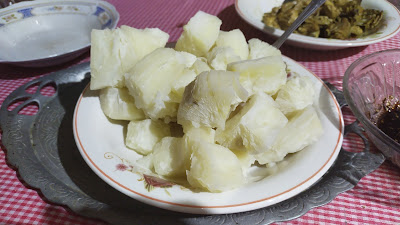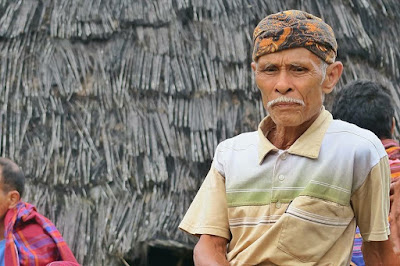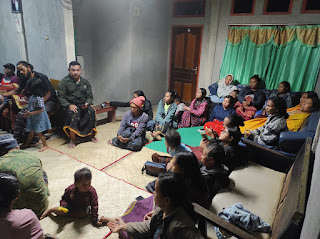Nuabosi Cassava
From Ende town it only took us 40 minutes to travel the 15km to Nuabosi village. In truth, it should only have taken us half the time, but we couldn't help pausing to enjoy the spectacular scenery on the way, the natural panoramas, the mountains trailing their verdant feet down to the sea, where jewel like small islands glistened in the warm sun, encapsulating the enchanting beauty of Flores.
Despite January being in
the rainy season, the weather in the coastal town of Ende was so scorchingly
hot as as we left, we felt we were living close to the sun, but this didn't
last too long as we approached Nuabosi, some 800m above sea level. The village,
to the north of Ende sits in a cauldron surrounded by hills and is much more
temperate. Nuabosi itself encompasses four village administrative areas,
Ntetundora I,II and III, and Randotonda.
I was visiting with my sister in law Kaka An and on our arrival we were escorted to her Uncle's home where we found him helping in construction of a neighbour's house, along with other villagers. This kind of mutual cooperation is rare in urban areas like where I live, but in villages like this, its common to find people working hand in hand to help their friends and neighbours in their construction projects. Still, it made a very positive impression on me. Kaka An's uncle is Father Yosafat Da, a father of four, who farms fields of clove, coconuts, vegetables and cassava. I was surprised to hear he didn't grow rice, the staple for everyone, and on hearing this immediately asked why. "You don't eat rice?" "Rice is still the main food "Bapa Yosafat replied, "but we buy rice from our earnings from selling cassava." And this is understandable.
Nuabosi is famous for its cassava, its name being
all but synonymous with the highest quality in Flores and highly valued. I was
curious, and immediately asked Bapa Yosafat to show me his famous cassava
garden. We walked there, passing through the beautiful village passing children
who had just come back from school, and mothers wearing colourful Ende woven
sarongs returning from the village hall where they had received their social
assistance, amidst waving coconut trees against a vivid blue sky.
 |
| Nuabosi Village |
On the fringes of the village we passed gardens
filled with cassava. Some had just been planted, others filled with mature
plants ready to be harvested. Two cows enjoyed eating grass in the shade of
coconut trees as we passed, and Kaka An had to remind us to avoid falling
coconuts.
Wearing a woven sarong and with a machete at his
waist, Bapa Yosafat led us on towards his garden which measures around three
quarters of a hectare, through those of his neighbours, full of cassava cloves
and coconuts, which cried out to be captured by my camera. When we reached his
property he started showing us his plants.
I was curious to know how he knew when the cassava
was ready to be harvested. It turned out that Bapa Yosafat has his own special
technique of shaking the stems of the plants to judge the size and condition of
the valuable roots. When he felt was heavy enough, it would be pulled out for
harvest.
He walked to a plant, positioning himself with his
body stretched out, knees bent, and pulled firmly on the stem, and suddenly a
tuber of cassava appeared, filled with six cassava roots.
He explained that in Nuabosi there are two classes
of cassava, Class One and Class Two, with Class One being particularly valued.
In terms of taste and aroma they have much in common, in that they smell good
and taste very good. But the significant difference lies in the texture.
"For second class cassava, when it is cooked and stored until it is cold,
the texture becomes hard" he said, "but for first class cassava, when
cooked and stored it remains soft" Class one also takes 14 months to reach
harvest point compared to just ten for class two.
I was so curious, I had to ask Bapa Yosafat just
how much profit he makes from selling his cassava and surprisingly he said the
price of class one and two cassava here was not much different. "For this
garden with second class cassava I can produce 10 million Rupiah (c. US$710)
per harvest". "The money is enough to meet daily needs, send children
to school, and so on." Bapa Yosafat added. Nuabosi's cassava is famed for
being larger and longer than normal crops. Its taste and texture are also
uniquely valued, which according to researchers from Undana Kupang University
in a 2019 project, are due to the local soil's structure and nutrient content,
affecting the tuber's content and texture when roasted. The outer skin is
slightly brownish pink, while the flesh is pure white and non-fibrous, soft and
sweet tasting.
They also survive in storage well. All of which
contribute to the price premium achieve on the market. After listening to Bapa
Yosafat's story, we went back to his home to meet his wife, Rosa Fatima who was
cooking. We gave her the cassava that Kaka An and her cousin had picked, for
her to peel and boil for us to taste. The plant is very versatile, class one
cassava being known as Tapioca Cassava, a basic ingredient for a flour, while
some can be processed into cassava chips, while we chose to try it prepared in
the traditional Nuabosi way, just peeled and cut to size, then washed and
boiled.
First class cassava takes just three minutes to be
cooked, second class two minutes more. "But it depends on the fire" Mama
explained. While waiting for the food to be prepared I talked to the Village
Head, Mr. Adrianus Renga, who though busy with village business took time to share
information about his area.
He explained that cassava is the main commodity
crop for the majority of the villagers. He told me that attempts had been made
to take the seed from Nuabosi to other areas to grow, but without success.
Another factor affecting the uniqueness of the product is that the unique soil
is never adulterated with fertiliser. Farmers sell their crops to middlemen who
then take it to markets across Flores where it finds ready buyers.
We were called back to Bapa Yosafat's house where
our boiled cassava was ready, together with the local coffee which unusually
was served only by a half glass, and enlivened with chili which despite the
high temperatures was welcome as the heavy rain set in. It was true what they
said about Nuabosi's cassava. It was so delicious that two full plates
disappeared into our empty lunchtime stomachs in a very short time. A delicious
change from our usual rice diet.
To me, this experience added to my love of Flores,
which is so rich in nature and culture. Nuabosi cassava has introduced me to
great people whose lives are simple but who still maintain their ancestral
values that have been passed down from generation to generation. For those of
you who are curious about the taste of Nuabosi cassava but have not been able
to visit the area, take it easy: almost every traditional market in Flores
sells it. Don't forget. Ask for Nuabosi cassava!



Komentar